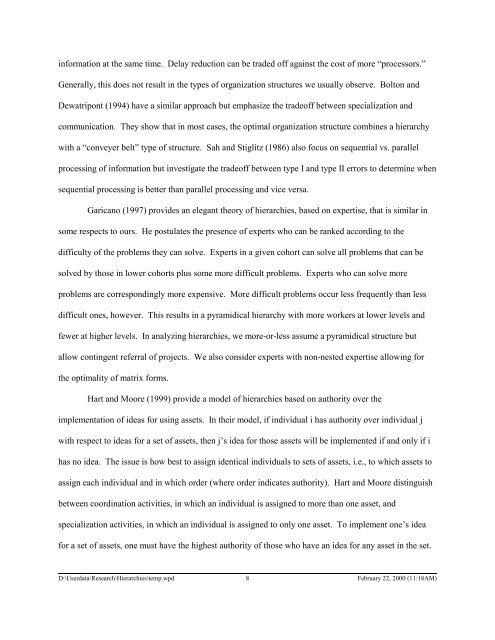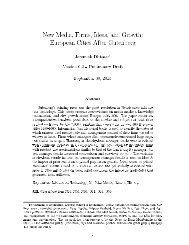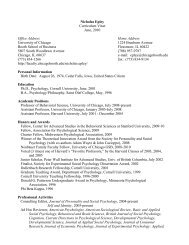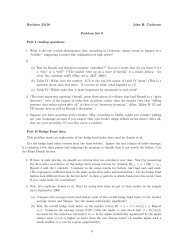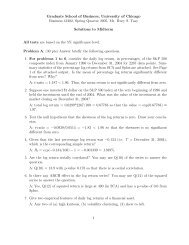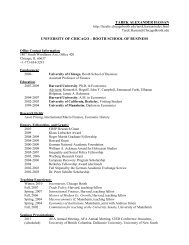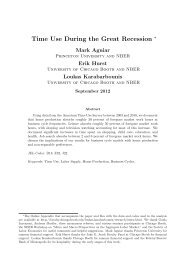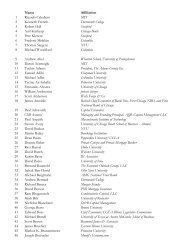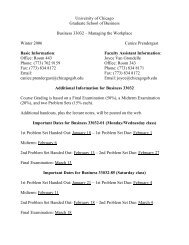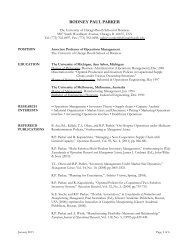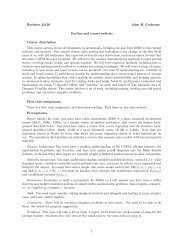by Milton Harris and Artur Raviv - Faculty
by Milton Harris and Artur Raviv - Faculty
by Milton Harris and Artur Raviv - Faculty
You also want an ePaper? Increase the reach of your titles
YUMPU automatically turns print PDFs into web optimized ePapers that Google loves.
information at the same time. Delay reduction can be traded off against the cost of more “processors.”<br />
Generally, this does not result in the types of organization structures we usually observe. Bolton <strong>and</strong><br />
Dewatripont (1994) have a similar approach but emphasize the tradeoff between specialization <strong>and</strong><br />
communication. They show that in most cases, the optimal organization structure combines a hierarchy<br />
with a “conveyer belt” type of structure. Sah <strong>and</strong> Stiglitz (1986) also focus on sequential vs. parallel<br />
processing of information but investigate the tradeoff between type I <strong>and</strong> type II errors to determine when<br />
sequential processing is better than parallel processing <strong>and</strong> vice versa.<br />
Garicano (1997) provides an elegant theory of hierarchies, based on expertise, that is similar in<br />
some respects to ours. He postulates the presence of experts who can be ranked according to the<br />
difficulty of the problems they can solve. Experts in a given cohort can solve all problems that can be<br />
solved <strong>by</strong> those in lower cohorts plus some more difficult problems. Experts who can solve more<br />
problems are correspondingly more expensive. More difficult problems occur less frequently than less<br />
difficult ones, however. This results in a pyramidical hierarchy with more workers at lower levels <strong>and</strong><br />
fewer at higher levels. In analyzing hierarchies, we more-or-less assume a pyramidical structure but<br />
allow contingent referral of projects. We also consider experts with non-nested expertise allowing for<br />
the optimality of matrix forms.<br />
Hart <strong>and</strong> Moore (1999) provide a model of hierarchies based on authority over the<br />
implementation of ideas for using assets. In their model, if individual i has authority over individual j<br />
with respect to ideas for a set of assets, then j’s idea for those assets will be implemented if <strong>and</strong> only if i<br />
has no idea. The issue is how best to assign identical individuals to sets of assets, i.e., to which assets to<br />
assign each individual <strong>and</strong> in which order (where order indicates authority). Hart <strong>and</strong> Moore distinguish<br />
between coordination activities, in which an individual is assigned to more than one asset, <strong>and</strong><br />
specialization activities, in which an individual is assigned to only one asset. To implement one’s idea<br />
for a set of assets, one must have the highest authority of those who have an idea for any asset in the set.<br />
D:\Userdata\Research\Hierarchies\temp.wpd 8 February 22, 2000 (11:18AM)


